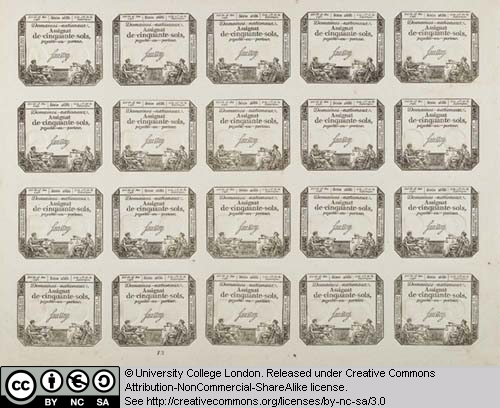12 Gatteaux

Nicolas Marie Gatteaux
(1751 – 1832)
Assignat de cinquante
sols, 1793 – 1796
Metal relief engraving
and embossed inkless stamp
As Richard Taws has noted in his recent PhD thesis,
assignats – paper banknotes of various denominations – were the most widely
circulated form of print in revolutionary
In common with other assignats, these fifty sol notes are
composed of a frame containing, at the top, a mechanically generated serial
number and a date (in both the Gregorian and Republican calendars).
The reference made to the law of 23rd May 1793 recalls the ruling that
increased the circulation of these notes, which had in fact been in circulation
since 1792. On the sides are warnings against counterfeiting assignats (a crime
punishable by death) and encouragement to inform against anyone guilty of
having done so.
The pictorial information contained within the frame
reinforces the rule of law through the depiction of appropriately accessorised
allegorical figures. Of the two women seated at the bottom of the note, the one
on the left is depicted writing the Rights of Man, the manifesto
embodying the principles of the Revolution published in 1791. At her feet sits
a cockerel, symbol of vigilance and wakefulness (in this instance against the
violation of those rights). The woman on the right embodies justice and
fraternity, symbolised by the pair of scales that she holds in one hand and the
fasces (a bundle of bound rods) in the other. Look closely and above them you
will see two timbres sec, embossed, inkless stamps, the one bearing the image
of a winged man and the inscription ‘Règne de la Loi’, ‘the rule of law’, the
other a female figure armed with the sword and scales of justice. Beside her
sits a tablet simply engraved with the word ‘loi’. Perhaps these virtuous
figures were chosen from the pantheon of revolutionary deities to try and deter
the host of forgers who were quickening the assignat’s depreciation. On a more
practical note, it was hoped the use of very detailed engravings and timbres
sec would reduce the chance of being able to successfully counterfeit the note.
The denomination of the note is specified within the frame
alongside the printed signature of Saussay. Signatories were not usually chosen
because they were important individuals – the equivalent of the governor of the
bank of
[1] Richard Taws, Currencies:
Circulation and Spectatorship in the Print Culture of the French Revolution, Unpublished
thesis (PhD), University of London, 2005. I would like to thank Richard for his
assistance whilst compiling this entry.
Licensed under the Creative Commons Attribution Non-commercial Share Alike 3.0 License
This resource has been released as an open educational resource (OER) on a Creative Commons 'Attribution Non-commercial Share Alike' license. This means that once downloaded, content can be modified and improved to complement a particular course. This requires, however, that improvements are recycled back into the OER community. All content present at the time of download must be accordingly credited and, in turn, novel content must be appropriately licensed.